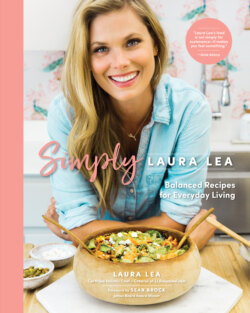Читать книгу Simply Laura Lea - Laura Lea - Страница 18
На сайте Литреса книга снята с продажи.
Оглавлениеadd farro. It’s important to note that farro is not
gluten- or wheat-free. Technically, “farro” refers to
three different strains of wheat grains, but the one
we typically find in the US is emmer wheat (we’ll
call it “farro” in the book). Farro is a source of free-
radical-fighting antioxidants, as well as soluble and
insoluble fiber, which can benefit digestion. Farro
offers zinc, B vitamins, and magnesium, which aid
various functions within the body. Magnesium can
improve heart health, PMS symptoms, and metabolic
syndrome conditions like diabetes. In the world of
grains, farro takes a bit longer to cook, but it is worth
the time. I know you will fall in love with farro too!
Frank’s RedHot
Here’s another ingredient you might not have been
expecting. But here’s the deal: the original Frank’s
RedHot sauce includes the following: aged cayenne
red peppers, distilled vinegar, water, salt, and garlic
powder—real ingredients you can pronounce,
which come together in a magnificent combination
to create a powerful flavor base for recipes. While I
love to make healthier versions of condiments (see:
Ranch (page 339), Caesar (page 339), and Italian (page 340) dressings in this book), I’m not above using something store-bought, if I approve of the nutrition. Frank’s RedHot is especially helpful when attempting to please those who may subsist on foods like fried wings, fake-cheese queso, and vegetable-oil laden potato chips. Likely, they will be familiar with the signature flavor of Frank’s and will be willing to give your dairy-free chicken dip or buffalo tempeh a try. In addition, consumption of chili peppers has been linked with decreased mortality and protection against obesity and metabolic syndrome. Much of this is attributed to capsaicin, the phytochemical in chili peppers responsible for their spiciness, because of its anti-inflammatory effect on adipose (fat) tissue. I love to pair the heat and acidity of Frank’s with healthy fats, such as tahini and coconut milk, and it’s lovely on both animal proteins and vegetables. Feel free to add a drop or two of Frank’s into some of the other savory recipes in this cookbook—just start slowly!
Miso
Hands down, miso paste is the ingredient I am most
excited to share throughout the pages of this book.
First things first: What the heck is miso? Miso is
a fermented paste that’s created by inoculating or
culturing soybeans with a mold called koji. Over a
period of time, ranging from weeks to years, koji
enzymes interact with organisms in the surrounding
environment to break down the beans into a savory,
rich, earthy paste—miso! In this book, we’ll be using
a mild, white miso paste (called “mellow” or “Shiro”).
It has a fairly short fermentation time, which results
in a lighter, brighter, and less pungent flavor than
its darker counterparts. Brown or red miso pastes
are the result of a longer fermentation period, and
they tend to be quite strongly flavored and salty.
According to the Japan Miso Promotion Board,
there are more than 1,300 different kinds of miso.
Personally, I haven’t met a miso I don’t like, but I find
that mild, white miso enhances other ingredients,
adding umami (the fifth taste next to sweet, savory,
salt, and acid), without overpowering them. In
addition to being a cook’s best secret weapon, miso
paste is incredibly healthful, full of vitamins E and
K, folic acid, and more. Miso is a fermented food, and
it is rich in probiotics that may be beneficial to your
gut microbiome. Medical studies have shown that
miso may help protect against a variety of cancers,
strokes, Irritable Bowel Syndrome, and more. It can
also help modulate immune system function and
manage allergies.
Kimchi
I’m telling you, Asian cuisine has the best
ingredients! Or, I should say, the best foods for
providing dynamite nutrition and flavor in one go.
I’ve been enjoying kimchi as a side dish for years,
but I only recently started integrating it into recipes,
such as my 5- Ingredient Kimchi Coleslaw (page 163) and my Cashew Kimchi Lettuce Cups (page 137). Like miso, kimchi is the result of fermentation alchemy. It begins as cabbage (usually), and it becomes a probiotic oasis, teeming with gut-friendly life and
